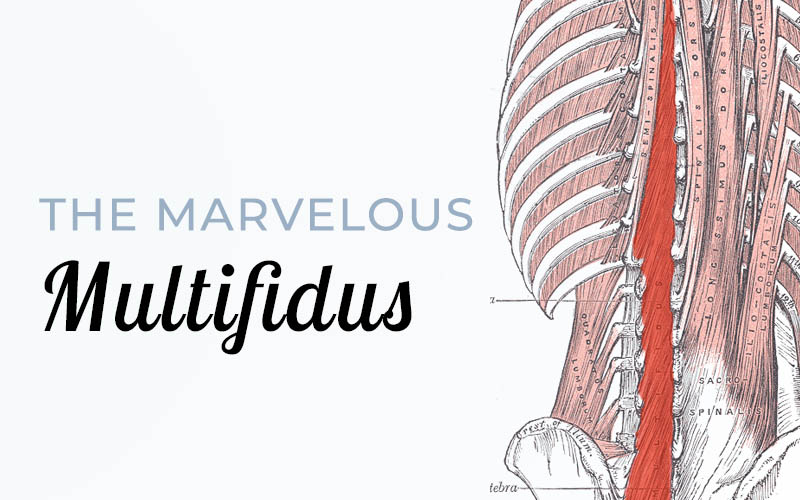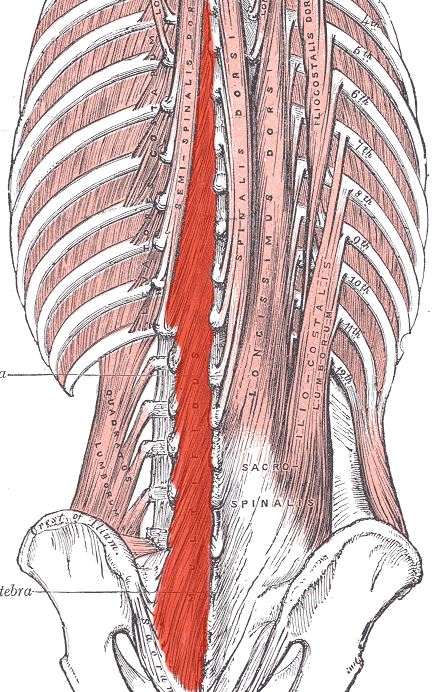
While it may seem mysterious and elusive, the multifidus, a spiky shaped muscle in your back, is integral to spine stability. Multifidi provide muscular support to the spine, which enables us to stand upright, or not fall over as we bend forward. When the multifidus is weak or atrophied, it often results in lower back pain. Instructing students on how to locate and use this muscle correctly is a difficult task for teachers to convey. But any frustration in the teaching process is a flash in the pan when a student makes the connection and is well on their way to relief from back pain.
The multifidus muscle is responsible for segmental stabilization of the spinal column, this supports the space between two or three vertebrae at once, but doesn’t stiffen up the entire spine. Without an active multifidus, lower back issues are almost certain. To gain the most from our multifidi, which plays a major therapeutic role for back health, let’s learn exactly where the multifidus is, and how we can teach students to incorporate this muscle in their movements.
The Transversospinalis Group

The multifidus muscle belongs to a group of muscles called the transversospinalis. These muscles include the rotatores, the multifidus, and the semispinalis, which are all located between the transverse and spinous processes of the spine. This picture diagrams the rotators as the deepest layer, with the semispinalis as the most superficial, and the marvelous multifidus sandwiched between the two.
Segmental Spinal Control
The multifidus contains short sections that cover two to three vertebrae. Imagine a pine tree with its draping boughs, this is similar to how the multifidus is structured. When both sides of the multifidus concentrically contract, the spine is segmentally drawn into extension, like a back bend. When only one side contracts, the spine moves into a side bend to the same side, and rotates to the opposite side. For example, if the left lumbar multifidi concentrically contract, the lumbar spine side bends to the left, and rotates to the right. Given the muscle’s relatively short length, the spine can articulate segmentally, one vertebra at a time.
The Multifidus and the “Core”
The multifidi work together with the transverse abdominus, which creates a symbiotic relationship to empower the back. Both muscles are core stabilizers, and connect through thoracolumbar fascia, a large wide soft tissue structure. When these muscles and fascial structures are engaged, they are fundamental to core alignment , and can alleviate chronic back pain or injury, caused by imbalanced musculature.
The Multifidus Leads the Way
Mastering the multifidi can be the first step to core stabilization. Then, a student can concentrate on co-contracting both the transverse abdominus and the pelvic floor. When all three of these muscles are activated simultaneously, the student can efficiently utilize the core for larger global, functional, and dynamic movements. This means relief from chronic back pain, and a return to life!
Please join the following exercise as I guide you to “feel” the contraction of the sacral and lumbar multifidus.
Swelling the Multifidus
Since the multifidus is beneath the semispinalis, it is not always easy to feel when it contracts. Rather than a large muscle popping out into your fingers, a multifidus contraction feels like a swelling of the muscle.

- Sit on a chair, directly on top of your sitz bones.
- Put your fingers on either side of the lumbar spinous processes (the bumps on the back of your spine), without touching them. If your thumbs are on your pelvic rim, and your fingers are slightly angled down, you will be palpating the transversospinalis group, approximately L4 and L5.
- Imagine your sitz bones wide, but the space under your fingers is narrowing.
- Visualize the vertebra above your fingers floating off the vertebra beneath them. (You may already feel some multifidi swelling.)
- Keep your back in line from head to tail and lean forward just a tiny bit. Try not to bend the spine. See if you can feel the subtle first stage of stabilization, which is the swelling of the multifidus. If you continue to lean forward, the more superficial muscle, the semispinalis, will strongly contract, popping into your fingers. If you don’t feel the swelling stage of the multifidus you may have gone too quickly, or your multifidus is not fully activating.
- Try this same exercise standing.
After you have successfully contracted the multifidus symmetrically, you can advance to more full body movements, and dynamic stabilization exercises.
Check out my Instagram and Facebook page for more movement insights!
Or if you live in NYC, please come visit us at the studio.
Mongoose Bodyworks is a boutique Pilates studio in Soho NYC that focuses on delivering customized private sessions designed for your exact needs.
Halle Clarke NCPT is a 2nd generation master teacher having studied closely with two of the great NYC protégés of Joseph Pilates: Kathy Grant and Romana Krysanowska. Halle opened Mongoose Bodyworks, a boutique Pilates Studio that offers personalized Pilates sessions in New York City in 1999.
As well as training in Pilates Halle has pursued studies in ideokensiology, anatomy, biomechanics, muscle energy technique, trigger point therapy, neuromuscular re-patterning, Alexander technique, The Feldenkrais Method, Polarity therapy and Cranio-Sacral Therapy. She has additional certifications from the PMA-CPT and ACE. Halle integrates all of her extensive studies of the body into her work as a New-York based Pilates Instructor and Teacher Trainer.
She has been conducting Pilates Teacher Trainings for Balanced Body since 2006 both in New York and around the country. Halle has taught Master Pilates classes nationally and internationally, including at The PMA Conference and Mind Body Expo.


